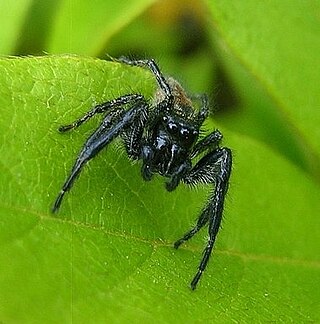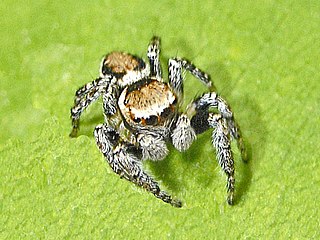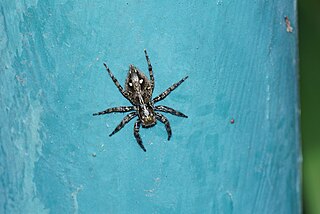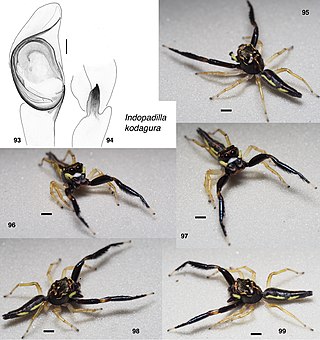
Carrhotus is a genus of jumping spiders that was first described by Tamerlan Thorell in 1891. The name is derived from the Greek Κάῤῥωτος.

Evarcha falcata is a species of 'jumping spiders' belonging to the family Salticidae.

Chrysilla volupe is a species of spider of the family Salticidae. It is found in Sri Lanka, India, Nepal, and Bhutan.

Aelurillus kopetdaghi is a species of jumping spider in the genus Aelurillus that lives in Turkmenistan. It was first described in 1996 by Wanda Wesołowska. The species is dark brown and medium-sized, with a bristly carapace that is between 3.4 and 3.5 mm long and a hairy abdomen that is between 3.2 and 4.1 mm long. The female is larger than the male. They also differ in details, such as the colour of the pedipalps, which are orange and brown respectively. The copulatory organs of the female are superficially similar to other species in the genus, like Aelurillus v-insignitus, but the internal structure is more complex.
Mogrus mirabilis is a species of jumping spider in the genus Mogrus that has been found in Egypt, Iraq, Jordan, Saudi Arabia, Sudan and Yemen. The spider was first defined in 1994 by Wanda Wesołowska and Anthony Van Harten. The female has a dark brown carapace that is typically 3.0 mm (0.12 in) and a greyish-white abdomen that is typically 4.7 mm (0.19 in) long. The male is significantly smaller and lighter, with a brownish-yellow carapace that is typically 2.38 mm (0.094 in) long and a yellow abdomen typically 2.5 mm (0.098 in) long. The male is similar to Mogrus antoninus, Mogrus frontosus and Mogrus logunovi, differing in the structure of its copulatory organs, particularly its bent tibial apophysis. The female is almost indistinguishable from Mogrus fulvovittatus, differing only in the structure of the epigyne. It is so similar to Mogrus sinaicus that Dmitri Logunov speculated that the two are the same species, although they have not been formally declared to be synonyms.

Aelurillus desertus is a species of jumping spider in the genus Aelurillus that is endemic to the United Arab Emirates. It was first described in 2010 by Wanda Wesołowska and Antonius van Harten. Initially only the male was described, the female following ten years later. The spider was originally classified in the genus Rafalus but was moved to its current genus at the same time as the female description was first published. The species is medium-sized with cephalothorax that is between 2.8 and 3.3 mm long and a abdomen that is between 2.8 and 4.8 mm long. The female is larger than the male. The carapace has a distinctive stripe. The female has three darker spots on the abdomen. The species can be distinguished by the existence of a triangular lobe on the palpal bulb on the male and the way that the copulatory openings are close to the rear of the epigyne on the female.

Menemerus nigli is a species of jumping spider in the genus Menemerus that originates in Asia. The male was identified in 2012 by Wanda Wesołowska and Mario Freudenschuss, and the female by Pir Asmat Ali, Wayne Maddison. Muhammad Zahid and Abida Buttin in 2018. The spider is medium-sized, typically 4.89 millimetres (0.193 in) in length, with a dark brown carapace and grey-brown abdomen that has a distinctive cream and white pattern created by small hairs. It was originally found in India, Pakistan and Thailand but was also found to have been introduced into Latin America, the first specimens being identified in Brazil in 2020. It seems to thrive amongst the sunlit stucco walls that are common in cities across the region. Menemerus nigli is used as an example of the ability of species that adapt to human habitation to expand their ecological niche and become global species.

Plexippus baro is a species of jumping spider in the genus Plexippus that lives in the Ethiopia. The male was first described by Wanda Wesołowska and Beata Tomasiewicz in 2008. The female has not been identified. The spider is medium-sized with a cephalothorax that is typically 2.7 mm (0.11 in) long and an abdomen 3.6 mm (0.14 in) long. The carapace is brown with three white stripes and the abdomen is russet-brown with a single white stripe. The spider has a pattern of two narrow white stripes on its clypeus which give it a distinctive face. The copulatory organs distinguish it from related species, particularly the male's longer embolus.

Plexippus fibulatus is a species of jumping spider in the genus Plexippus that lives in Kenya. It was first described in 2016 by Angelika Dawidowicz and Wanda Wesołowska. Only the male has been described. In 2017, Jerzy Prószyński suggested that it should be reclassified in its own genus as it does not resemble other Plexippus spiders but this has not been carried out. It is a medium-sized spider, with a cephalothorax between 2.9 and 3.3 mm long and an abdomen between 2.9 and 3.3 mm long. The dark brown carapace is marked with streaks made of white hairs and the brown abdomen has a pattern consisting of a white streak and chevrons. The spider has a short fleshy embolus and a spike-like tibial apophysis, after which is named, that is set perpendicular to the tibia.

Plexippus lutescens is a species of jumping spider in the genus Plexippus that lives in Namibia and Zimbabwe. It was first described in 2002 by Wanda Wesołowska. Only the male has been described. In 2017, Jerzy Prószyński declared it should be reclassified as the spider has a different palpal bulb to others in the genus, but this was not undertaken. It is a medium-sized spider, with a cephalothorax typically 3.3 mm (0.13 in) long and an abdomen that is 4 mm (0.16 in) long. The dark brown carapace has three white stripes and the reddish-brown abdomen has a single stripe of lighter brown. The spider has a short tibial apophysis and thin embolus. It lacks the lateral lobe on the palpal bulb that is visible on other species in the genus.

Plexippus minor is a species of jumping spider in the genus Plexippus that lives in the United Arab Emirates. The male was first described by Wanda Wesołowska and Antonius van Harten in 2010 and the female in 2020. The spider is medium-sized with a cephalothorax between 3.1 and 3.8 mm long and an abdomen between 3.3 and 4.1 mm long. It has a shape and colouring typical of the genus. The male has a orange carapace while the female is brownish-fawn. The copulatory organs distinguish it from related species, particularly the male's shorter embolus and tibial apophysis and the female's wide pocket on its epigyne.

Plexippus tsholotsho is a species of jumping spider in the genus Plexippus that lives in South Africa and Zimbabwe. It was first described in 2011 by the Polish arachnologist Wanda Wesołowska. The species was first found in the Zimbabwean district of Tsholotsho, after which the species is named. Only the female has been described. It is a large spider, with a cephalothorax 4 mm (0.16 in) long and abdomen 5.2 mm (0.20 in) long. It is generally dark brown in colour, with a lighter brownish orange tint to the rear of the carapace and a white stripe along the body of the abdomen. It is distinguished from the otherwise similar Plexippus paykulli in the shape of the copulatory ducts in the epigyne and the presence of significant sclerotization around the gonopores.

Plexippoides regius is a species of jumping spider in the genus Plexippoides. The species was first described by Wanda Wesołowska in 1981 based on specimens from North Korea but its distribution has been extended to include China and Russia, with examples found as far as Sichuan. The spider is small, with a body length between 6.9 and 8.65 mm, the female being generally larger than the male. It is distinguished by the two brown lines that stretch across the back of its carapace and abdomen. Otherwise, the spider varies in coloration, with some examples having an orange or yellow-brown carapace and others dark brown. The male has a long embolus that encircles the palpal bulb. The female has complex seminal ducts that lead to heavily sclerotised and many-chambered spermathecae.
Katya is a genus of Southeast Asian jumping spiders first described by Jerzy Prószyński & Christa Deeleman-Reinhold in 2010. As of April 2019 it contains only three species. This genus is named after the Uzbek arachnologist Ekaterina Andreeva.
Proszynskia is a small genus of south Asian jumping spiders erected by N. Kanesharatnam and Benjamin in 2019 after a molecular phylogenetic study of south Asian spiders showed the relationship between two species previously belonging to Marpissa and Phintella. They are large for jumping spiders, growing up to 7 to 9 millimetres long. The thin abdomen has a yellow stripe between two black stripes.
Megaeupoa is a small genus of Asian jumping spiders first described by Y. J. Lin and S. Q. Li in 2020. It was not explicitly assigned to a position within the Salticidae, but the name Megaeupoa refers to the "evolutionary relationship" of the genus. As of March 2022 it contains only two species: M. gravelyi and M. yanfengi.

Indopadilla is a genus of jumping spiders first described by J. T. D. Caleb, P. M. Sankaran and K. S. Nafin in 2019. It was placed into the tribe Baviini in the Salticoida clade of Salticinae. Several species have been transferred from the genus Bavia.

Cosmophasis lami, also known as the Lami Beach northern jumping spider or tangerine garden jumper, is a species of jumping spider in the genus Cosmophasis, probably native to South East Asia and some pacific islands, and possibly introduced to Japan and Okinawa Islands by humans. It was first described by Berry, Beatty & Prószynski in 1997 and has one synonym, Cosmophasis squamata (Saaristo,2002) Both the female and the male have been described.

Asianopis is a genus of Asian net-casting spiders first described by Y. J. Lin, L. Shao and A. Hänggi in 2020.

Chrysillini is a tribe of jumping spider in the family Salticidae. In Maddison's 2015 revision of the family, the subfamily Heliophaninae was reclassified as a junior synonym of Chrysillini.
















